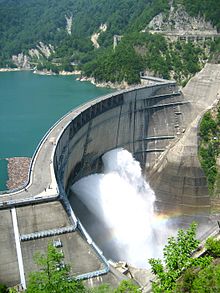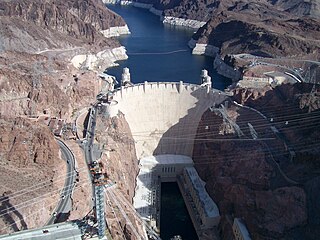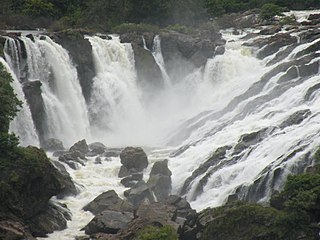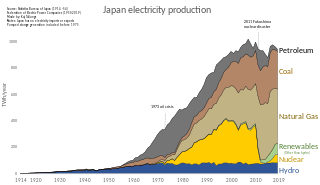List of hydroelectric power stations





Hydroelectricity is the second most important renewable energy source after solar energy in Japan with an installed capacity of 50.0 gigawatt (GW) as of 2019. [1] According to the International Hydropower Association Japan was the world's sixth largest producer of hydroelectricity in 2020. Most of Japanese hydroelectric power plants are pumped-storage plants. Conventional hydropower plants account for about 20 GW out of the total installed capacity as of 2007. [2]
Conventional hydropower potential of Japan is considered to be almost fully developed, with little opportunity for further capacity increase. [3] In recent years, almost exclusively pumped storage plants were commissioned, significantly increasing the ratio of pumped storage capacity over conventional hydro. [3] The large capacity of pumped storage hydropower was built to store energy from nuclear power plants, which until the Fukushima disaster constituted a large part of Japan electricity generation. As of 2015, Japan is the country with the highest capacity of pumped-storage hydroelectricity in the world, with 26 GW of power installed. [4] After the 2011 nuclear power shutdowns, pumped-storage plants have been increasingly used to balance the variable generation of renewable energy sources such as solar, which have been growing rapidly in recent years. [4]
As of September 2011, Japan had 1,198 small hydropower plants with a total capacity of 3,225 megawatt (MW). The smaller plants accounted for 6.6% of Japan's total hydropower capacity. The remaining capacity was filled by large and medium hydropower stations, typically sited at large dams. Cost per kilowatt-hour for power from smaller plants was high at ¥15-100, hindering further development of the energy source. [5]






Renewable energy is energy from renewable natural resources that are replenished on a human timescale. The most widely used renewable energy types are solar energy, wind power and hydropower. Bioenergy and geothermal power are also significant in some countries. Some also consider nuclear power a renewable power source, although this is controversial. Renewable energy installations can be large or small and are suited for both urban and rural areas. Renewable energy is often deployed together with further electrification. This has several benefits: electricity can move heat and vehicles efficiently, and is clean at the point of consumption. Variable renewable energy sources are those that have a fluctuating nature, such as wind power and solar power. In contrast, controllable renewable energy sources include dammed hydroelectricity, bioenergy, or geothermal power.

Small hydro is the development of hydroelectric power on a scale suitable for local community and industry, or to contribute to distributed generation in a regional electricity grid. Exact definitions vary, but a "small hydro" project is less than 50 megawatts (MW), and can be further subdivide by scale into "mini" (<1MW), "micro" (<100 kW), "pico" (<10 kW). In contrast many hydroelectric projects are of enormous size, such as the generating plant at the Three Gorges Dam at 22,500 megawatts or the vast multiple projects of the Tennessee Valley Authority.

Pumped-storage hydroelectricity (PSH), or pumped hydroelectric energy storage (PHES), is a type of hydroelectric energy storage used by electric power systems for load balancing. The method stores energy in the form of gravitational potential energy of water, pumped from a lower elevation reservoir to a higher elevation. Low-cost surplus off-peak electric power is typically used to run the pumps. During periods of high electrical demand, the stored water is released through turbines to produce electric power. Although the losses of the pumping process make the plant a net consumer of energy overall, the system increases revenue by selling more electricity during periods of peak demand, when electricity prices are highest. If the upper lake collects significant rainfall or is fed by a river then the plant may be a net energy producer in the manner of a traditional hydroelectric plant.

Hydroelectricity, or hydroelectric power, is electricity generated from hydropower. Hydropower supplies one sixth of the world's electricity, almost 4,500 TWh in 2020, which is more than all other renewable sources combined and also more than nuclear power. Hydropower can provide large amounts of low-carbon electricity on demand, making it a key element for creating secure and clean electricity supply systems. A hydroelectric power station that has a dam and reservoir is a flexible source, since the amount of electricity produced can be increased or decreased in seconds or minutes in response to varying electricity demand. Once a hydroelectric complex is constructed, it produces no direct waste, and almost always emits considerably less greenhouse gas than fossil fuel-powered energy plants. However, when constructed in lowland rainforest areas, where part of the forest is inundated, substantial amounts of greenhouse gases may be emitted.
India is the third largest producer of electricity in the world. During the fiscal year (FY) 2022–23, the total electricity generation in the country was 1,844 TWh, of which 1,618 TWh was generated by utilities.
For solar power, South Asia has the ideal combination of both high solar insolation and a high density of potential customers.
As of August 2020 Chile had diverse sources of electric power: for the National Electric System, providing over 99% of the county's electric power, hydropower represented around 26.7% of its installed capacity, biomass 1.8%, wind power 8.8%, solar 12.1%, geothermal 0.2%, natural gas 18.9%, coal 20.3%, and petroleum-based capacity 11.3%. Prior to that time, faced with natural gas shortages, Chile began in 2007 to build its first liquefied natural gas terminal and re-gasification plant at Quintero near the capital city of Santiago to secure supply for its existing and upcoming gas-fired thermal plants. In addition, it had engaged in the construction of several new hydropower and coal-fired thermal plants. But by July 2020 91% of the new capacity under construction was of renewable power, 46.8% of the total solar and 25.6% wind, with most of the remainder hydro.
According to the International Hydropower Association, Canada is the fourth largest producer of hydroelectricity in the world in 2021 after the United States, Brazil, and China. In 2019, Canada produced 632.2 TWh of electricity with 60% of energy coming from Hydroelectric and Tidal Energy Sources).

China is the world's largest electricity producer, having overtaken the United States in 2011 after rapid growth since the early 1990s. In 2021, China produced 8.5 petawatt-hour (PWh) of electricity, approximately 30% of the world's electricity production.

India is the world's 4th largest consumer of electricity and the world's 3rd largest renewable energy producer with 40% of energy capacity installed in the year 2022 coming from renewable sources. Ernst & Young's (EY) 2021 Renewable Energy Country Attractiveness Index (RECAI) ranked India 3rd behind USA and China. In FY2023-24, India is planning to issue 50 GW tenders for wind, solar and hybrid projects. India has committed for a goal of 500 GW renewable energy capacity by 2030. In line with this commitment, India's installed renewable energy capacity has been experiencing a steady upward trend. From 94.4 GW in 2021, the capacity has gone up to 119.1 GW in 2023 as of Q4.
There is a large array of stakeholders that provide services through electricity generation, transmission, distribution and marketing for industrial, commercial, public and residential customers in the United States. It also includes many public institutions that regulate the sector. In 1996, there were 3,195 electric utilities in the United States, of which fewer than 1,000 were engaged in power generation. This leaves a large number of mostly smaller utilities engaged only in power distribution. There were also 65 power marketers. Of all utilities, 2,020 were publicly owned, 932 were rural electric cooperatives, and 243 were investor-owned utilities. The electricity transmission network is controlled by Independent System Operators or Regional Transmission Organizations, which are not-for-profit organizations that are obliged to provide indiscriminate access to various suppliers to promote competition.

Hydroelectricity is, as of 2019, the second-largest renewable source of energy in both generation and nominal capacity in the United States. In 2021, hydroelectric power produced 31.5% of the total renewable electricity, and 6.3% of the total U.S. electricity.

India is 5th globally for installed hydroelectric power capacity. As of 31 March 2020, India's installed utility-scale hydroelectric capacity was 46,000 MW, or 12.3% of its total utility power generation capacity. Additional smaller hydroelectric power units with a total capacity of 4,683 MW have been installed. India's hydroelectric power potential is estimated at 148,700 MW at 60% load factor. In the fiscal year 2019–20, the total hydroelectric power generated in India was 156 TWh with an average capacity factor of 38.71%.

The electric power industry in Japan covers the generation, transmission, distribution, and sale of electric energy in Japan. Japan consumed approximately 918 terawatt-hours (TWh) of electricity in 2014. Before the 2011 Fukushima Daiichi nuclear disaster, about a quarter of electricity in the country was generated by nuclear power. In the following years, most nuclear power plants have been on hold, being replaced mostly by coal and natural gas. Solar power is a growing source of electricity, and Japan has the third largest solar installed capacity with about 50 GW as of 2017. Japan's electricity production is characterized by a diverse energy mix, including nuclear, fossil fuels, renewable energy, and hydroelectric power.

The electricity sector in Switzerland relies mainly on hydroelectricity, since the Alps cover almost two-thirds of the country's land mass, providing many large mountain lakes and artificial reservoirs suited for hydro power. In addition, the water masses drained from the Swiss Alps are intensively used by run-of-the-river hydroelectricity (ROR). With 9,052 kWh per person in 2008, the country's electricity consumption is relatively high and was 22% above the European Union's average.
The Polish energy sector is the fifth largest in Europe. By the end of 2023, the installed generation capacity had reached 55.216 GW, while electricity consumption for that year was 167.52 TWh and generation was 163.63 TWh, with 26% of this coming from renewables.

As of 2018, hydroelectric power stations in the United Kingdom accounted for 1.87 GW of installed electrical generating capacity, being 2.2% of the UK's total generating capacity and 4.2% of UK's renewable energy generating capacity. This includes four conventional hydroelectric power stations and run-of-river schemes for which annual electricity production is approximately 5,000 GWh, being about 1.3% of the UK's total electricity production. There are also four pumped-storage hydroelectric power stations providing a further 2.8 GW of installed electrical generating capacity, and contributing up to 4,075 GWh of peak demand electricity annually.

Renewable energy in Taiwan contributed to 8.7% of national electricity generation as of end of 2013. The total installed capacity of renewable energy in Taiwan by the end of 2013 was 3.76 GW.

Renewables supply a quarter of energy in Turkey, including heat and electricity. Some houses have rooftop solar water heating, and hot water from underground warms many spas and greenhouses. In parts of the west hot rocks are shallow enough to generate electricity as well as heat. Wind turbines, also mainly near western cities and industry, generate a tenth of Turkey’s electricity. Hydropower, mostly from dams in the east, is the only modern renewable energy which is fully exploited. Hydropower averages about a fifth of the country's electricity, but much less in drought years. Apart from wind and hydro, other renewables; such as geothermal, solar and biogas; together generated almost a tenth of Turkey’s electricity in 2022. Türkiye has ranked 5th in Europe and 12th in the world in terms of installed capacity in renewable energy. The share of renewables in Türkiye’s installed power reached to 54% at the end of 2022.

Hydroelectricity is currently China's largest renewable energy source and the second overall after coal. According to the International Hydropower Association, China is the worlds largest producer of hydroelectricity as of 2021. China's installed hydroelectric capacity in 2021 was 390.9 GW, including 36.4 GW of pumped storage hydroelectricity capacity, up from 233 GW in 2011. That year, hydropower generated 1,300 TWh of power, an increase of 68 TWh over 2018 when hydropower generated 1,232 TWh of power, accounting for roughly 18% of China's total electricity generation.